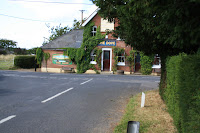 ading a transformer so the pub which I think was dated 1347 was bereft of my delectable company. The place looks good too!
ading a transformer so the pub which I think was dated 1347 was bereft of my delectable company. The place looks good too! The Red Lion at Hernhill
So I had no choice but to walk but first I had a look around the churchyard and admired the views from the cemetary. I also noted the sign that told me about the men who were buried after the battle - the followers of Sir William. Sad really because they followed a man who was, according to many who reported at the time, was totally off his trolley. I have read a little about the man and believe he was a deluded
 by his own ego into believeing he was the savior of the local farmworkers who were suffering from a great technological change - farm machinery that threatened to make them redundant. At the time the Captain Swing riots were in, excuse the pun, full swing and this must have influenced the workers when Sir William took up their cause.
by his own ego into believeing he was the savior of the local farmworkers who were suffering from a great technological change - farm machinery that threatened to make them redundant. At the time the Captain Swing riots were in, excuse the pun, full swing and this must have influenced the workers when Sir William took up their cause.The sign in Hernehill churchyard
Anyway I decided that I should try a walk and headed past the Red Lion from the church and at the end of Swale View beside the playground there was a public footpath which led to and between apple orchards. I crossed a road and followed the path to rejoin the road a little further along. To my right was the the rolling green of fields and woods that I think are part of the Blean Woods -
 maybe not - and eventually I arrived at The Dove, a pub which was closed but at 4pm I could hear noises of chairs and stools being readied. The place looks good with a car park and a garden bar and Shepherd Neame which is a bonus. From there I walked along the road searching for a pathway and eventually came upon a restricted byway which led through a farm yard and out to posts with yellow arrows on them. I took the wrong one which led to the main Thanet Way but ho hum at least I was able to walk along the sidepath to a turning which took me away from the noise.
maybe not - and eventually I arrived at The Dove, a pub which was closed but at 4pm I could hear noises of chairs and stools being readied. The place looks good with a car park and a garden bar and Shepherd Neame which is a bonus. From there I walked along the road searching for a pathway and eventually came upon a restricted byway which led through a farm yard and out to posts with yellow arrows on them. I took the wrong one which led to the main Thanet Way but ho hum at least I was able to walk along the sidepath to a turning which took me away from the noise.
In fact I arrived in Hernehill along the road I had started on. The pub was still closed so I took some photos and took off.
I must say that Hernehill is a pretty place and forms part of a small enclave of villages that includes Boughton Under Blean and Dunkirk from where more can be discovered about the Battle of Bossenden Woods. The Red Lion at Dunkirk was where the bodies were taken after the battle although, as I have said, some of the dead were buried at Hernehill. 

As can be seen from the view above there are some wonderful views to be had from Hernhill church. The orchards of the local farmers and those of Mount Ephraim are visible from the hill and are well worth the visit. I can also recommend a visit to the Mount Ephraim Gardens.













